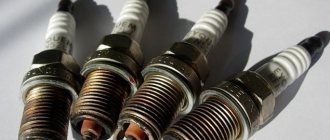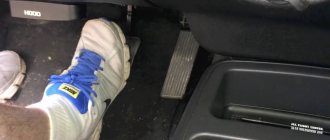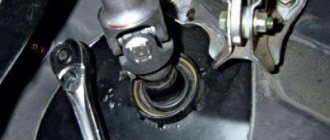Unusual knocking and vibration when braking can be caused by a number of reasons, which are listed below. All of them, to some extent, can affect the proper operation of the braking system. Under no circumstances should you put off fixing this problem! Faulty brakes can cause irreparable harm not only to the driver, but also to his passengers, surrounding pedestrians, and cars.
Popular phrases from car owners who are faced with this problem: “the pedal hits”, “when braking from the nth speed a strong vibration begins”, “the higher the speed, the stronger the vibration”, “beating on the steering wheel when you press the brake” and etc.
On vehicles equipped with an ABS system, knocking on the pedal when braking on a slippery road is considered normal. This is how this system works by relieving and restoring pressure using a special pump. Frequent operation of the shut-off valve (modern ABS can raise and release pressure up to 15 times in 1 second) causes pulsating high-frequency vibration. Unfortunately, such systems were not installed on VAZ classic cars.
Note: The anti-lock braking system intelligently applies the brakes to the wheels on slippery roads, preventing them from locking and slipping. Thus, when ABS is operating, stopping occurs faster, and the driver maintains control of the car while pressing the brake pedal.
But do not confuse the operation of ABS with possible malfunctions of the brake system, which will be discussed below.
Causes of vibration during braking and methods of elimination
- Brake disc deformation.
Replace or sharpen the disc (preferably in pairs).
Grind or replace the drum.
Tighten the wheel hub nut and replace the bearing if necessary.
If there is no noticeable vibration, but if strange grinding sounds appear, we recommend reading the article: creaking, whistling and squealing brakes.
Drivers go to auto repair shops when something has already broken down, and completely ignore the symptoms that appear long before a serious breakdown. For example, the steering wheel vibrates when braking.
What could this mean? Is this serious? Let's not guess, but let's deal with the beating of the steering wheel.
Diagnostics
Checking brake discs with a micrometer;
So, we have looked at the probable causes of the brake pedal beating. How can we determine which of them played a negative role in this particular machine? This requires a comprehensive and thorough diagnosis. And it is best if the research is carried out in a specialized car service center.
As part of diagnostic activities, the following work is performed:
- checking the geometry of discs and drums;
- checking the pads;
- testing of wheel bearings;
- inspection of suspension fasteners.
The geometry of discs and drums is checked on a special stand, which accurately records the curvature of the flat pressure pad of the disc and the ellipticity of the inner surface of the drum. To determine the degree of pad wear, use a caliper or micrometer. The condition of the wheel bearings is determined using special equipment that determines the amount of camber and toe-in of the rotating wheels from the normal position.
Why does the steering wheel shake when braking? Possible reasons
So, why does the steering wheel shake when braking, or while driving at speed?
The options could be:
- Steering wheel beating at idle speed when the car is stationary;
- The steering wheel shakes when driving at different speeds;
- The steering wheel vibrates when braking.
Steering wheel beating at idle
They arise, as a rule, due to loose fastenings of the power unit, and the problem can intensify when starting off.
There is another option - the steering rack shaft or its splined part begins to “die”. This malfunction is extremely dangerous, since at any moment you risk being left without control of the machine. In a word, urgently call for service;
Steering wheel shakes when driving at different speeds
In most cases, everything is not as scary as in the previous paragraph and the solution to the problem lies in the wheels.
The most common cause is dirt or snow that has clogged up the discs, causing imbalance and vibration at speed.
If no dirt is found, then there is a high probability of the wheels being out of balance as such - perhaps you recently changed tires or installed fancy wheels.
Also, such runouts are typical for tires whose geometry is broken. That is, a “hernia” came out as a result of hitting a curb or a stone, as well as as a result of a tire breaking when driving on a flat tire.
In the worst case, these vibrations may indicate wear of the suspension elements - listen more carefully to the car, if the steering wheel hits especially hard when cornering, then it is possible that it is time to change the constant velocity joints or the silent blocks of the front levers;
Steering wheel vibrates when braking
A typical problem, the cause of which lies in the brake mechanisms, or more precisely, in the discs or drums.
Usually problems arise due to the fact that for some reason the disk or drum has moved and it has simply become crooked, so when braking the whole system shakes.
Sometimes the steering wheel shakes at speed when braking after a poor-quality repair or, what is much worse, due to a crack in the brake disc or drum. As a rule, all this is treated by replacing the mechanisms.
Disc imbalance
One of the reasons when the steering wheel shakes at speed may be the wheel disc itself (which is defective). Often even a new product has an imperfect shape. Serious inconsistencies in composition are also possible. Therefore, the weight differs in different areas. The central part of the wheel stretches to where the mass is greater. This is centrifugal force. Since the center will constantly shift, the centrifugal force also changes direction. Therefore, the steering wheel will vibrate through the tie rod chain at high speeds.
conclusions
Dear readers and car enthusiasts, if you feel that the steering wheel is vibrating when braking, or this happens at idle, or when picking up a certain speed, urgently call for service.
When braking, the steering wheel shakes for a reason; this annoying twitching is a symptom of serious and even dangerous malfunctions.
For my part, I wish you only pleasant driving, and let no problems distract you from driving the car.
Until we meet again, and, as they say, neither nail nor rod for you!
Steering wheel wobble when braking is a serious safety concern. The spreading vibration throughout the car, day after day, destroys its elements, bringing costly repairs closer. Therefore, if the steering wheel shakes when braking, the car owner should not try to hold the steering wheel tighter, but take action as soon as possible. Let's consider the causes of this malfunction.
Author of the article: mudriy_lev Specialization: repair of auto generators and servos in cars. Place of work: service center. Experience: 2 years. Education: higher education - electrical engineer, secondary specialized education - mechanical assembly mechanic.
What to do if a wheel breaks on a Lada Granta
When the fret wheel of a Grant knocks, you must first find out where the knock is coming from. When it becomes clear, fix (if possible) or replace the required part.
Replacing a tire with a new one
Continuing to drive on a tire with a herniation is putting yourself and your passengers in danger. No matter what they do at the tire shop, the tire will still not be like new. Therefore, it is worth replacing the tire so that the car behaves confidently on the road.
Replacing the brake disc with a new one
If the disk has led, there is no point in aligning or sharpening it. To prevent the new brake disc from misbehaving like the old one, you need to use engine braking on wet roads. Perhaps we need to install a better braking system that will withstand intense braking. Despite this, no brake system will withstand strong temperature changes, and the disc will start to move.
Replacing or rolling a wheel rim
Rolling a disc is the process of aligning it against indentations. When the disk is slightly damaged, the geometry can be restored by rolling. But more often, cracks appear in titanium discs, which are then welded.
Replacing the Lada Granta disc
If the situation with the disc is extremely sad, the tire shop will tell you about it, and you will have to buy a new one.
Replacing the hub bearing
The Lada Granta wheel hits when the bearing fails. To replace it, you first need to remove it from the hub and then press it out. The new bearing is pressed in using a hydraulic press. There are presses in almost every workshop that deals with car chassis. If you don’t have a press, but want to save money, then it’s better to remove the bearing along with the hub and take it to a service center. They will charge much less for pressing and pressing than for a full cycle of work. After replacing the bearing, the play of the front or rear wheel on the Grant will be eliminated.
Wheel hub axle tightening
The reasons for the ringing inside the drum of the rear wheels of the Grant may be due to the destruction of the drum or a broken spring. If it turns out that the wheel hub axle is simply not tightened, this is the most advantageous method. You just need to tighten the bolts.
Wheel bolt tightening
To prevent the wheel from spinning further on the road, you need to tighten it with a torque from 186.3 to 225.6 Hm. The bolts must be tightened diagonally.
Steering rack replacement or repair
The steering rack is being repaired. To make the steering play less, you need to tighten the rack. A special key is used for this.
Replacing the steering rack
If you cannot tighten the rail yourself, it is better to have it repaired. You can repair it much cheaper than buying a new one.
Wheel imbalance
If the steering wheel beats are observed not only during braking, but also when the car is moving, and vibration changes its amplitude and frequency when the speed changes, then the first thing the car owner should pay attention to is wheel balancing.
First you need to check the presence of balancing weights. Correct balancing cannot be optimally performed in a garage, so it is advisable to visit a service station, where professionals will quickly complete this task using special equipment.
How is a malfunction diagnosed?
To identify the runout of one of the front wheels, you will need a jack, wheel chocks and a wheel wrench. The diagnostic procedure is as follows:
- Park the machine on level ground and pull the handbrake all the way. Additionally, secure the car with boots placed under any rear wheel.
- Jack up the front wheel until it hangs off the ground. On vehicles with front-wheel drive and all-wheel drive, be sure to move the gearshift lever to neutral.
- Rotate the suspended rim with your hands. If you feel stuck in a certain position, remove the wheel and check that the uneven disc is rubbing against the pads, causing strong vibration when braking.
Bumps on tires
Before going to the service station, you need to inspect the tires. All dirt must be removed from them with a brush. By the way, the very presence of dirt can also cause wheel imbalance.
On tires that have been cleaned of dirt and debris, it is necessary to visually check for the absence of bulges and depressions. Any damage to the wheel can cause the steering wheel to wobble not only when braking but also when the car is moving.
If tire damage is detected, you must contact specialists to restore them, or purchase new tires.
When inspecting tires, you should also pay attention to the condition of the caps and rims. Any damage to them may be the reason why the steering wheel shakes when braking.
Wheel alignment
An incorrect wheel alignment angle can also cause the steering wheel to vibrate when the car is braking.
Signs that indicate the need to check your wheel alignment:
- the car was in an accident
- suspension repair was carried out
- steering wheel repaired
- the car crashed into a hole
- car crashed into curb
If the suspension elements are worn out, before adjusting the wheel alignment, it is necessary to carry out repairs and replace the worn-out elements. Otherwise, you will have to check the wheel alignment every few trips.
Wear of the front wheel brake system
At this stage of the automotive industry, 2 types of brakes are used:
- disk (installed on almost all cars)
- drum (due to low efficiency they left the market, but are still found in budget cars, for example, “Zaporozhets”)
The most common cause of steering wheel beating is bending of the brake system elements as a result of overheating and subsequent uneven cooling. Drum brakes are more closed, and this situation rarely happens with them. In most cases, vibration in drum brakes occurs due to excessive wear of the brake mechanism and is eliminated by completely replacing the drum elements.
The symptom that accompanies the beating of the steering wheel and confirms the fault of the brake system quite often manifests itself in beating of the brake pedal.
Reasons why the steering wheel wobbles due to the fault of the brake system:
- overheating and uneven cooling of the disk
- poor quality pads
- uneven rusting
- incorrect installation
When a car moves at high speed during braking, a large amount of energy is released, which is converted into heat due to friction.
When overcoming a puddle or snowdrift, part of the disk is intensively cooled. This causes waves to form on it. Subsequently, each wave hits the brake pad strongly and this causes vibration of the entire wheel, which in turn is transmitted in the form of beating to the steering wheel.
To detect this malfunction, it is necessary to visually inspect each brake disc.
To eliminate this malfunction, the discs are resurfaced at a service station or replaced.
It must be taken into account that the groove thins the disk and if it overheats, it will warp even more. Therefore, replacing the disk with a new one, if your budget allows, is a much better solution to the problem.
The block itself, being a static element, is not capable of causing the steering wheel to wobble. However, poor-quality pads can wrap unevenly on the brake disc and the situation will be similar to the resulting waves.
Uneven rusting appears on the brake discs of cars that are not used frequently. The water between the pad and the disc dries out more slowly, and if it becomes jammed, it can remain at the point of contact for months. As a result, the disc rusts unevenly and a beating appears on the steering wheel.
If a runout on the steering wheel appears after installing new brake discs, then the reason lies in improper installation. The brake disc must be tightened gradually and in a crosswise pattern. At low-quality service stations, this rule is neglected and the owner gets a wobble in the steering wheel.
To correct this situation, the brake disc must be reattached.
Wheel problems
It is precisely problems with stingrays that cause the mentioned phenomenon in most cases. Let's consider them in descending order, according to the possible likelihood of their occurrence.
In 70% of cases of runout during braking at speed, wheel imbalance is to blame. Failure to adjust the ramp leads to the appearance of centrifugal force - the heavier part of the wheel pulls its center towards itself. The result is body shaking with vibration transferred to the steering wheel. The loss of one or more weights is determined simply: the beating appears at speeds greater than 60 km/h and when braking from there. When eliminating a defect, it is important not to make a mistake: correct balancing is carried out not on the pair of wheels where its violation was noticed, but on all 4.
The next most common reason is defects in tires and wheels. Flying into a hole or lateral collision with a curb disrupts the geometry of the latter, and the slope gives vibration not only to the steering wheel, but throughout the entire body. In some cases, it will not be possible to detect curvature visually. However, you can jack up the car and turn the wheel. If it is loose, take it to a tire shop and have it checked at a stand. As for tires, the culprit may be a manufacturing defect that led to the formation of lumps, or perhaps road damage to the cord.
Next in line is low tire pressure. It rarely happens to those who watch their wheels, but even the most attentive driver can run into a stud along the way. It is worth checking the pressure in the slopes and pumping them up to normal - perhaps such simple actions will immediately remove the beating.
Poor tightening of wheel bolts is a primitive reason, but often overlooked and, moreover, the cause of many accidents. Please note that it is possible for the bolts to spontaneously loosen while driving, say, on a “washboard”.
In any case, when runout occurs during braking, especially at high speeds, the wheels are carefully inspected first. If you were unable to find a defective one, go to a tire shop and entrust the diagnostics to professionals.
Wheel mount and steering wheel runout
If the wheel fastening is broken or loosened, there may be quite a strong beating on the steering wheel when stopping the car. In this case, sharp braking can cause overload and tear the wheel off the car. Therefore, this reason why the steering wheel shakes is the most dangerous.
To prevent and eliminate this malfunction, it is necessary to visually inspect the car’s wheels as often as possible. And if malfunctions are detected, you must decide whether to repair it yourself or call a tow truck.











